Contents:
- Supreme Court to hear petition on Delhi violence
- No larger Bench for Article 370 case
- India monitoring impact of U.S.-Taliban deal
- Access to Internet is not negotiable: Law Minister
- Solid proof not must for establishing citizenship
- EU raises alert as virus toll crosses 3,000
- Hackers may have access to your smart device
- OECD lowers India’s FY21 GDP growth to 5.1%
- Oil up over 2% on OPEC cut, stimuli hopes
SUPREME COURT TO HEAR PETITION ON DELHI VIOLENCE
Focus: GS-II Governance, Prelims
Why in news?
- Chief Justice of India (CJI) Sharad A. Bobde on Monday orally said courts were not “equipped” to handle palpable “pressure” being created to somehow step in and prevent violence in Delhi.
- The observations came when a senior advocate made a mentioning before him to urgently intervene and pass directions to arrest those delivering hate speeches and to prevent the spread of violence.
What did the Petition seek? (Way Forward)
- Amongst other things like seeking action against those delivering hate speeches and to prevent the spread of violence -The Petition also sought:
- The setting up of a Special Investigation Team (SIT) with officers from outside Delhi to probe the February riots in Delhi.
- Setting up of an inquiry committee headed by a retired judge should probe the police persons involved.
- Exemplary compensation to be granted to victims.
- That the Centre should be directed to call in the Army if the law and order situation further deteriorates.
- That the full list of persons detained by the police and paramilitary forces made public and CCTV footage of riot-affected areas preserved.
- The immediate release of post-mortem reports to the victims’ families.
Provisions to reduce Violence:
Article 239 AA
- The National Capital Territory of Delhi has been given with powers of law-making and administration to an elected legislature and the council of ministers. However, the law puts two subjects directly under the Union government that includes public order and police.
- There are exceptions in this law which include the Sections 129 & 130 of Criminal Procedure Code (CrPC).
- If a group is found in unlawful assembly under Section 129, the Executive Magistrate can issue orders to these persons to disperse.
- If this fails, the magistrate can use the civil force which is the police.
- If these efforts fail too, the Executive Magistrate under Section 130 can call an officer of the armed forces of the Union to disperse the assembly.
- This section states that it can be invoked for “public security”.
- Therefore, under these two limited powers, the Executive Magistrate (who reports to CM) can issue orders relating to public security.
Is the Provision for National Capital Territory (NCT) of Delhi different from that for States?
- The public order and police are the subjects under the state list.
- So, the state government may request the Union government to make available armed forces to help restore public order.
- Even in circumstances where public disorder is not as serious as to fall in the category of an “internal disturbance” under the Article 355 of the Constitution, the Union Government may accede to the request.
- Neither the state government nor any of its authority has been conferred by the Constitution any legal right to call the armed forces while dealing with a public disorder or “internal disturbance”.
- The exception for this is Section 130 CrPC.
- Also, the 7th Schedule of the Constitution states that use of the armed forces in the maintenance of public order is outside the states’ purview. [7th Schedule – Deals with the subject of public order in the state list.]
Section 130 of CrPC
Use of armed forces to disperse assembly.
(1) If any such assembly cannot be otherwise dispersed, and if it is necessary for the public security that it should be dispersed, the Executive Magistrate of the highest rank who is present may cause it to be dispersed by the armed forces.
(2) Such Magistrate may require any officer in command of any group of persons belonging to the armed forces to disperse the assembly with the help of the armed forces under his command, and to arrest and confine such persons forming part of it as the Magistrate may direct, or as it may be necessary to arrest and confine in order to disperse the assembly or to have them punished according to law.
(3) Every such officer of the armed forces shall obey such requisition in such manner as he thinks fit, but in so doing he shall use as little force, and do as little injury to person and property, as may be consistent with dispersing the assembly and arresting and detaining such persons.
CrPC
- The Code of Criminal Procedure commonly called Criminal Procedure Code (CrPC) is the main legislation on procedure for administration of substantive criminal law in India.
- It was enacted in 1973 and came into force on 1 April 1974.
- It provides the machinery for the investigation of crime, apprehension of suspected criminals, collection of evidence, determination of guilt or innocence of the accused person and the determination of punishment of the guilty.
- It also deals with public nuisance, prevention of offences and maintenance of wife, child and parents.
NO LARGER BENCH FOR ARTICLE 370 CASE
Focus: GS-II Governance, Prelims
Why in news?
A five-judge Constitution Bench led by Justice N.V. Ramana on Monday declined a plea to refer to a larger Bench petitions challenging the abrogation of special status of Jammu and Kashmir under Article 370 of the Constitution.
The Bench said it would continue to hear the case on merits.
Conflict in Past Judgements on Status of Jammu and Kashmir
- The Bench had heard arguments and reserved its decision on whether there was a “direct conflict” between the judgments of 1959 and 1970 on the nature and extent of Article 370.
- The 1959 judgment, Prem Nath Kaul versus State of Jammu and Kashmir, indicated that Article 370 was applicable only till the Jammu and Kashmir Constitution was enacted on January 26, 1957. After that, no further changes could be made to the relationship between India and Jammu and Kashmir.
- But some petitioners argued that the Sampath Prakash versus State of Jammu and Kashmir judgment had ignored the 1959 verdict by concluding that Article 370 was permanent in nature and a “perennial source of power” for the Centre to govern its relationship with J&K.
Supreme Court’s Order on the Claimed Conflict
- Justice Ramana concluded that there was no conflict.
- The court explained that the “Constitution Bench in the Prem Nath Kaul case- did not discuss the continuation or cessation of the operation of Article 370 after the dissolution of the Constituent Assembly of the State.
- This was not an issue in question before the court, unlike in the Sampat Prakash case, where the contention was specifically made before, and refuted by, the court”.
- The order concluded that the court saw no reason to read into the Prem Nath Kaul case an interpretation that resulted in it being in confliict with its subsequent judgments.
Background
- On 5th August 2019, President of India in the exercise of the powers conferred by Clause (1) of Article 370 of the Constitution had issued the Constitution (Application to Jammu and Kashmir) Order, 2019. Through this, Government of India has made modifications in Article 370 itself (not revoked it).
- With this, the Government of India had dramatically altered the relationship between the state of Jammu and Kashmir and the Indian Union.
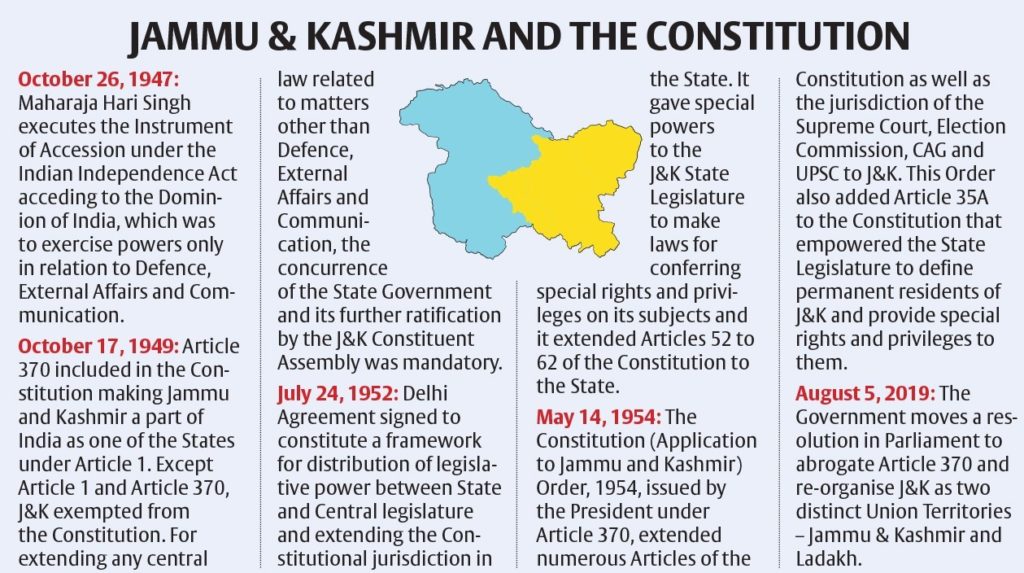
More about Article 370 of the past
- On October 17, 1949, Article 370 was added to the Indian constitution, as a ‘temporary provision’, which exempted Jammu & Kashmir, permitting it to draft its own Constitution and restricting the Indian Parliament’s legislative powers in the state.
- It was introduced into the draft constitution by N Gopalaswami Ayyangar as Article 306 A.
- Under Article 370: The Constituent Assembly of Jammu & Kashmir was empowered to recommend which articles of the Indian Constitution should apply to the state.
- The J&K Constituent Assembly was dissolved after it drafted the state’s constitution.
- Clause 3 of the article 370 gives the President of India the power to amend its provisions and scope.
- Article 35A stems from Article 370 and was introduced through a Presidential Order in 1954, on the recommendation of the J&K Constituent Assembly.
- Article 35A empowers the Jammu & Kashmir legislature to define the permanent residents of the state, and their special rights and privileges.
- It appears in Appendix I of the Constitution.
INDIA MONITORING IMPACT OF U.S. – TALIBAN DEAL
Focus: GS-II International Relations, Prelims
Why in news?
External Affairs Minister S. Jaishankar said on 2nd March 2020 that India was “watching the space” closely to ensure that gains of the past two decades were not lost after U.S. signed a deal with Taliban.
India’s Concerns Not Addressed
- While India has raised concerns over the future of democracy, human rights, women’s rights and other achievements made in Afghanistan since 2001, when the Taliban regime was last defeated, the issues were not addressed in the agreement between the U.S. and Taliban signed on February 29. The agreement provides a timetable for withdrawal of the U.S. troops from Afghanistan by May 2021 and an intra-Afghan dialogue in March 2020.
Significance Afghanistan with respect to India
- Afghanistan is a strategic investment for India, and India has made significant contributions to the rebuilding of the country.
- Indian is engaged with
Afghanistan by following ways:
- Developing social infrastructure as hospitals, schools;
- Public infrastructure such as Salma dam, and parliament building ;
- Humanitarian assistance such as medical missions;
- Training of military officer and soldiers;
- Military warfare such as military helicopters and repairing the old soviet era helicopters.
- Afghanistan is a gateway for The International North–South Transport Corridor (INSTC) for India.
- India’s development of the Chabahar Port is of great strategic importance for the development of regional maritime transit traffic to Afghanistan and Central Asia
- Afghanistan is also involved in The Turkmenistan–Afghanistan–Pakistan–India Pipeline (TAPI) Project.
- Afghanistan can help India to overcome/oppose China’s The Belt and Road Initiative (BRI, or B&R), formerly known as One Belt One Road (OBOR) initiative.
- Afghanistan can help fulfil India’s Oil demands.
INSTC
The International North–South Transport Corridor (INSTC) is a multi-modal connectivity project to establish transport networks (ship, rail, and road route) for moving freight between India, Russia, Iran, Europe and Central Asia.
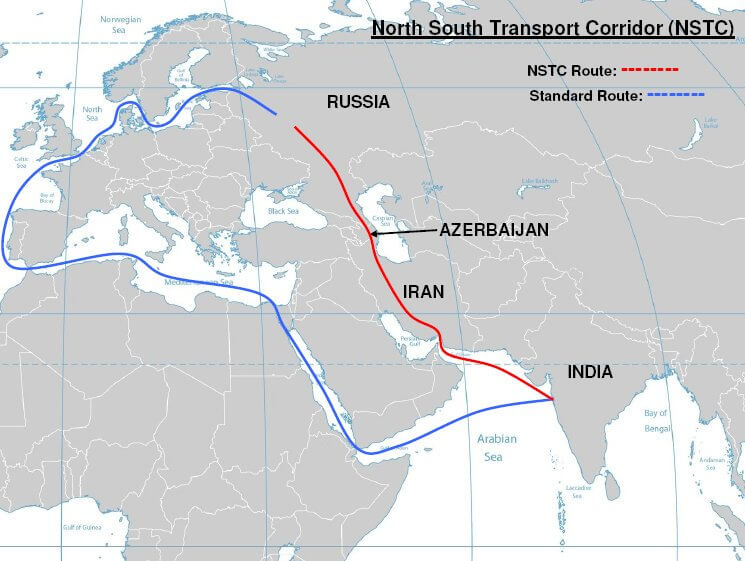
- It links Indian Ocean and Persian Gulf to the Caspian Sea via Iran, and then onwards to northern Europe via St. Petersburg in Russia.
- The route primarily involves moving freight from India, Iran, Azerbaijan and Russia via ship, rail and road.
- The objective of the corridor is to increase trade connectivity between major cities such as Mumbai, Moscow, Tehran, Baku, Bandar Abbas, Astrakhan, Bandar Anzali and etc.
- The current members are India, Iran, Russia, Azerbaijan, Kazakhstan, Armenia, Belarus, Tajikistan, Kyrgyzstan, Oman, Syria, Turkey, Ukraine, and Bulgaria (observer).
- Turkmenistan currently is not a formal member but is likely to have road connectivity to the corridor, after being formally invited by Prime Minister Narendra Modi.
Chabahar Port
- This port is Located on the Gulf of Oman and is the only oceanic port of the country.
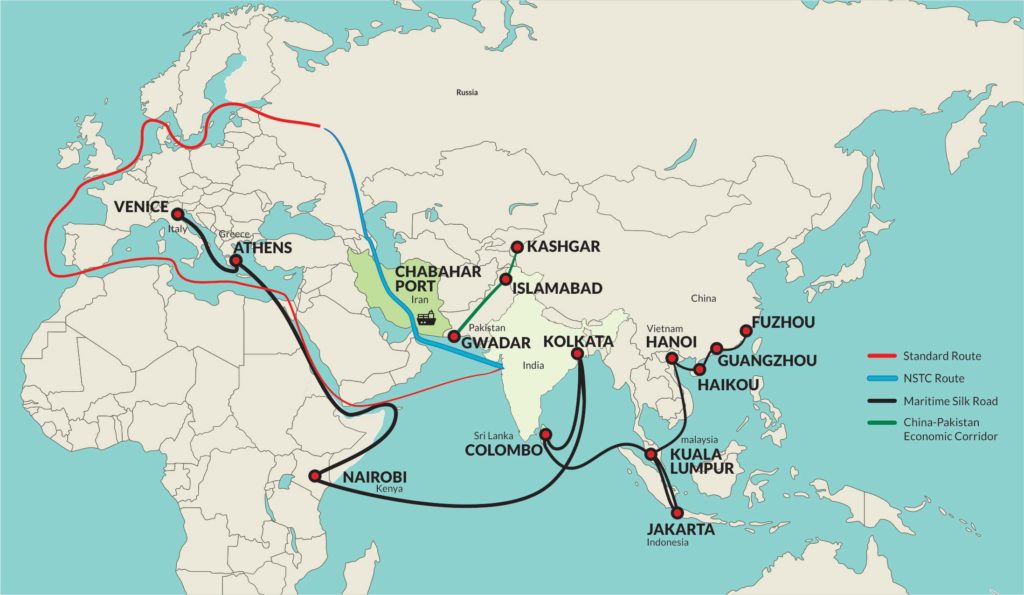
- With this, India can bypass Pakistan in transporting goods to Afghanistan.
- It will also boost India’s access to Iran, the key gateway to the International North-South Transport Corridor that has sea, rail and road routes between India, Russia, Iran, Europe and Central Asia.
- It also helps India counter Chinese presence in the Arabian Seawhich China is trying to ensure by helping Pakistan develop the Gwadar port. Gwadar port is less than 400 km from Chabahar by road and 100 km by sea.
- With Chabahar port being developed and operated by India, Iran also becomes a military ally to India. Chabahar could be used in case China decides to flex its navy muscles by stationing ships in Gwadar port to reckon its upper hand in the Indian Ocean, Persian Gulf and Middle East.
- Trade benefits: With Chabahar port becoming functional, there will be a significant boost in the import of iron ore, sugar and rice to India. The import cost of oil to India will also see a considerable decline. India has already increased its crude purchase from Iran since the West imposed ban on Iran was lifted.
- From a diplomatic perspective, Chabahar port could be used as a point from where humanitarian operations could be coordinated.
TAPI
- The Turkmenistan–Afghanistan–Pakistan–India Pipeline (TAPI), also known as Trans-Afghanistan Pipeline, is a natural gas pipeline being developed by the Galkynysh – TAPI Pipeline Company Limited.
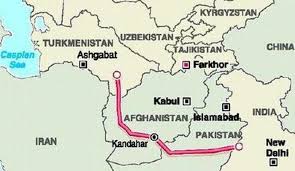
- The pipeline will transport natural gas from the Galkynysh Gas Field in Turkmenistan through Afghanistan into Pakistan and then to India.
- The pipeline will begin pumping natural gas by the beginning of 2020 and supply life is expected to last for 30 years.
- The TAPI Project is considered as an important initiative of these four countries to connect energy rich Central Asia with energy starved South Asia.
- It will provide an alternative supply source of gas with dependable reserves leading to enhanced energy security.
- It will further diversify the fuel basket to the benefit of Indian economy as it would be used mainly in power, fertilizer and city gas sectors.
ACCESS TO INTERNET IS NOT NEGOTIABLE: LAW MINISTER
Focus: GS-II Indian Polity, Prelims
Why in news?
Union Law Minister Ravi Shankar Prasad on 2nd march 2020 – said access to Internet is plainly non-negotiable as it flows from the right to information.
He also said that, the international arbitration centre at the National Capital, established under the New Delhi International Arbitration Act of 2019, would be “completely autonomous”. Foreign arbitrators would be permitted.
Supreme Court on Access to Internet and Fundamental Right
- The Supreme Court had declared, on January 2020, that – Access to Internet is a Fundamental Right. A government cannot deprive the citizens of fundamental rights except under certain conditions explicitly mentioned in the Constitution.
- The ruling came on hearing of a plea in connection with Internet blockade in Jammu and Kashmir since August 5 — in the view of revoking of Article 370 in the Union Territory.
- Indian constitution makes the right to freedom of speech and expression a fundamental right for all citizens- listed in Article 19 (1)(a) of the Constitution. The Supreme Court has on many occasions expanded the scope of the right to freedom of speech and expression.
- The Supreme Court ruling is also in sync with the United Nations recommendation that every country should make access to Internet a fundamental right.
- A state cannot technically declare a service, facility or a kind protection as fundamental right as it requires interpretation of (by high courts and/or the Supreme Court) or amendment to the Constitution by Parliament.
Article 19. Protection of certain rights regarding freedom of speech etc.,
Clause (1) All citizens shall have the right
- to freedom of speech and expression;
- to assemble peaceably and without arms;
- to form associations or unions;
- to move freely throughout the territory of India;
- to reside and settle in any part of the territory of India; and
- omitted
- to practise any profession, or to carry on any occupation, trade or business
The State can enact laws that imposes reasonable restrictions on the exercise of the right in the Interests of:
- the sovereignty and integrity of India,
- the security of the State,
- friendly relations with foreign States,
- public order, decency or morality
- in relation to contempt of court, defamation or
- incitement to an offence
SOLID PROOF NOT MUST FOR ESTABLISHING CITIZENSHIP
Focus: GS-II Governance
Why in news?
Proof beyond all reasonable doubts is not required in a Foreigners Tribunal (FT) for establishing one’s citizenship, the Gauhati High Court has observed.
The Gauhati High Court observed that strict rules of evidence were not applicable to the tribunals “established for quick disposal of the matters sent to it”.
What is a tribunal?
- Tribunal is a quasi-judicial institution that is set up to deal with problems such as resolving administrative or tax-related disputes. It performs a number of functions like adjudicating disputes, determining rights between contesting parties, making an administrative decision, reviewing an existing administrative decision and so forth.
- A Tribunal, generally, is any person or institution having an authority to judge, adjudicate on, or to determine claims or disputes – whether or not it is called a tribunal in its title.
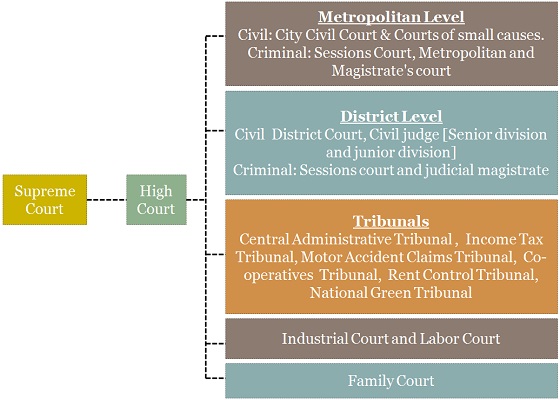
EU RAISES ALERT AS VIRUS TOLL CROSSES 3,000
Focus: GS-III Science and Technology
Why in news?
The death toll from COVID19 outbreak surpassed 3,000 on 2nd March 2020 as more people died in China, Iran and the U.S. and Europe raised its state of alert.
The new coronavirus, also called SARSCoV2, has now infected more than 89,000, spread to over 60 countries and threatens to cause a global economic slowdown.
Rising spread
In the last 24 hours there were almost nine times more COVID19 cases reported outside China than inside China.
About Corona Virus
- Coronaviruses are a large family of viruses, including some that cause the common cold to some that cause major diseases.
- The 2019-nCoV belongs to this group of viruses, six of which, including the 2003 Severe Acute Respiratory Syndrome (SARS) and the 2012 Middle East Respiratory Syndrome (MERS) viruses, were earlier known to cause disease in humans.
- The new name is taken from the words “corona”, “virus” and “disease”, with 2019 representing the year when it emerged (the outbreak was reported to the WHO on 31st December, 2019).
- The WHO wanted to avoid stigmatizing a country or particular group, so it chose a name that did not refer to a geographical location, an animal, an individual or a group of people.
- Moreover, the word coronavirus refers to the group of viruses it belongs to, rather than the latest strain. The latest strain has been designated ‘Severe Acute Respiratory Syndrome Coronavirus 2 (SARS-CoV-2)’ by the International Committee on Taxonomy of Viruses.
HACKERS MAY HAVE ACCESS TO YOUR SMART DEVICE
Focus: GS-III Science and Technology
Why in news?
iPhone, iPad, Amazon Echo or Kindle or certain handsets from Google, Samsung or Xiaomi, is exposed to have a vulnerable WiFi chips that allowed hackers to access data from the handset.

- Once a hacker gets access to any device for even a short period of time, they can do anything, including planting a malware or intercepting sensitive information that is being sent or received via the Internet.
- Indian cybercrime agencies are currently trying to gauge the number of devices featuring these two chips in circulation in the country to get a sense of the magnitude of the problem.
Related Indian Cybercrime Agency in the news recently: I4C
- The Indian Cyber Crime Coordination Centre (I4C) was recently inaugurated by the government.
- The scheme to set up I4C was approved in October 2018, to deal with all types of cybercrimes in a comprehensive and coordinated manner.
- It will be set up under the newly created Cyber and Information Security (CIS) division of the MHA.
- The I4C will assist in centralising cyber security investigations, prioritise the development of response tools and bring together private companies to contain the menace.
OECD LOWERS INDIA’S FY21 GDP GROWTH TO 5.1%
Focus: GS-III Indian Economy, Prelims
Why in news?
Global agency OECD on 2nd March, 2020, lowered its India’s GDP growth forecast to 5.1 per cent from the earlier projection of 6.2 per cent for 2020 on concerns of impact of deadly coronavirus on the domestic as well as the global economy.
Details of the report:
- The Organisation for Economic Cooperation and Development (OECD) said the adverse impact on confidence, financial markets, travel sector and disruption to supply chains contributes to the downward revisions in all G20 economies in 2020, particularly ones strongly interconnected to China.
- The report said coronavirus (COVID-19) outbreak has already brought considerable human suffering and major economic disruption.
- Output contractions in China are being felt around the world, reflecting the key and rising role China has in global supply chains, travel and commodity markets. Subsequent outbreaks in other economies are having similar effects, albeit on a smaller scale.
OECD
- The Organisation for Economic Co-operation and Development (OECD) is an international, intergovernmental economic organization of 36 countries. OECD was founded in the year 1961 to stimulate world trade and economic progress.
- Most OECD members are high-income economies with a very high Human Development Index (HDI) and are regarded as developed countries. OECD members are democratic countries that support free-market economies.
- It provides a platform for its member countries to compare policy experiences, seek answers to common problems, identify and share best practices and coordinate domestic and international policies of its member nations.
Functions of OECD
- The OECD is responsible for publishing economic reports, statistical databases, analyses, and forecasts on the outlook for economic growth worldwide.
- The group analyzes the impact of social issues on economic growth and makes recommendations to foster economic growth globally. These recommendations extend forethoughts to the environmental concerns associated with economic development too.
- The organization endeavors to eliminate bribery and other forms of financial crimes worldwide.
- The OECD also maintains a “blacklist” of nations that are considered uncooperative tax havens.
- It also took efforts to eradicate tax avoidance by profitable corporations and in the G-20 countries. It also encourages the G-20 countries to promote tax reforms.
OIL UP OVER 2% ON OPEC CUT, STIMULI HOPES
Focus: GS-III Industry and Infrastructure
Why in news?
- Oil prices jumped more than 4 per cent, up from multi-year lows hit earlier on 2nd March 2020, as hopes of a deeper cut in output by OPEC and stimulus from central banks countered worries about damage to demand from the coronavirus outbreak.
- The unprecedented disruption to economic activity in China has resulted in an estimated 4 million b/d of lost oil demand compared to 5 million b/d during the Great Recession in 2008/09
OPEC
- The Organization of the Petroleum Exporting Countries is an intergovernmental organization of 14 nations, founded on 14 September 1960 in Baghdad by the first five members (Iran, Iraq, Kuwait, Saudi Arabia, and Venezuela), and headquartered since 1965 in Vienna, Austria.
- As of September 2018, the 14 member countries accounted for an estimated 44 percent of global oil production and 81.5 percent of the world’s “proven” oil reserves, giving OPEC a major influence on global oil prices that were previously determined by the so-called “Seven Sisters” grouping of multinational oil companies.
- The stated mission of the organization is to “coordinate and unify the petroleum policies of its member countries and ensure the stabilization of oil markets, in order to secure an efficient, economic and regular supply of petroleum to consumers, a steady income to producers, and a fair return on capital for those investing in the petroleum industry.”




